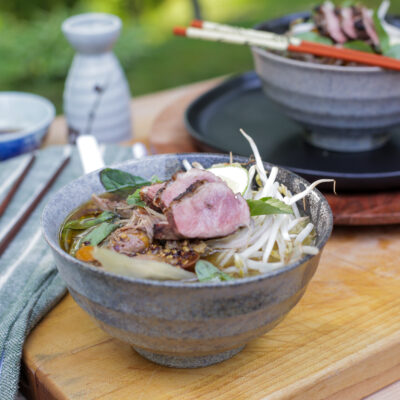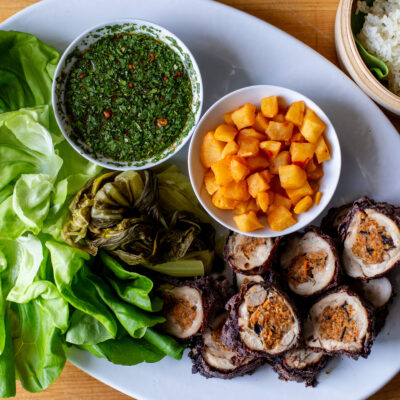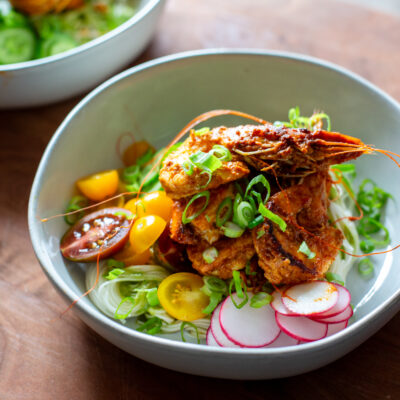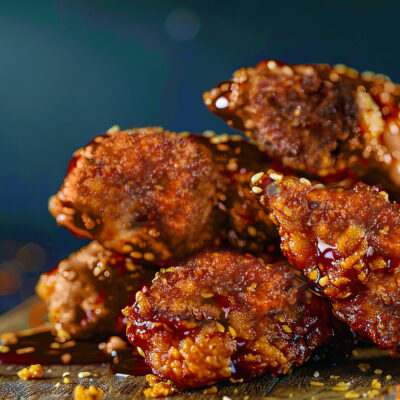My Favorite Korean Noodle Dish
By Andrew Zimmern
Korean food is bound to the earth. Their culture understands wellness, health, and diet are indispensably tied together. I love cooking Korean food, especially dishes like Japchae, a dish made with sweet potato starch noodles and a dozen vegetables, some meat if you care to, and a simple seasoning blend of soy sauce, sugar, and toasted sesame oil. The dish is delicious, but like much of Korean food, it’s the attention to detail that goes into a specific preparation that I enjoy. It’s like a moving meditation, I get to take my time and be as precise as I can be. A bird’s beak paring knife makes cleaning shrimp a breeze. And a nakiri or vegetable cleaver are ideal for chopping the vegetables, ensuring each one is sliced thin to mimic the shape of the noodles. The way you prepare the ingredients is essential to the success of the dish. My family and friends can taste all the love I put into the noodle dish when we eat, communally as we connect.
Knives used:
Bird’s Beak

A bird’s beak is a classic tool for making decorative cuts—such as radish rosettes or fluted mushrooms—as well as for cutting out blemishes, peeling, and slicing soft fruits such as nectarines or plums. The curved shape lets you cut close to the peel, keeping more of the fruit or vegetable.
Nakiri

In Japan, a nakiri is a vegetable knife. It’s designed to handle a full range of vegetables, and a lot more, with ease. Use it with a simple push cut instead of a rocking cut. The straighter edge means more of the blade contacts the board with each cut for extremely efficient slicing and dicing.
Cleaver
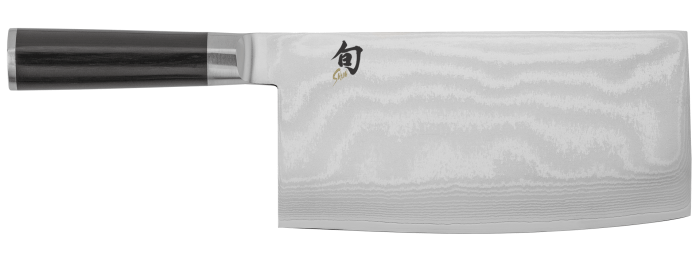
This Chinese cleaver is a large, squared knife with a very wide blade. It is a multi-purpose knife—the Chinese answer to a chef’s knife. It’s especially useful for processing vegetables, especially larger ones such as cabbage. Yet this cleaver is nimble enough for almost every kind of cutting and slicing, from fruits and vegetables to a full array of proteins.
Shrimp Japchae
Ingredients
Shrimp
- 1 pound U-15 sized shrimp, peeled and deveined, then halved lengthwise
- 1 tablespoon toasted sesame oil
- 2 tablespoons rice wine (sake, or if you have it, soju made from rice)
- 1 tablespoon mirin
- 2 cloves garlic, passed through a Micro-plane
Cooking Sauce
- 1 tablespoon ground black pepper
- 2 whole dried hot chiles, chopped
- 1/4 cup brown sugar
- 2 tablespoons toasted sesame oil
- 1/4 cup rice wine (sake, or if you have it, soju made from rice which is tricky to find)
- 2 tablespoons mirin
- 2 cloves garlic passed through a Micro-plane
- 1/4 cup soy sauce
Vegetables
- 1/3 cup toasted canola oil or plain canola oil for sauteeing the veg etc
- 2 beaten eggs
- 1 bunch scallions, chopped
- 1 red bell pepper, stems and seeds removed, thinly sliced
- 1 onion, thinly sliced
- 8 ounces shiitake mushrooms, thinly sliced
- 1 carrot, julienned
- 1 handful fresh spinach
- 2 cups thinly sliced savoy or napa cabbage
- 8 ounces dangmyeon (sweet potato starch noodles)
- 2 tablespoons toasted sesame oil for the noodles
- 2 tablespoons toasted sesame seeds
Instructions
Get a large pot of salted water going for cooking the noodles.
In a large bowl, combine the shrimp, sesame oil, rice wine, mirin and garlic. Let sit at room temperature for a half hour while you prep the other ingredients.
In a second bowl, combine all of the ingredients for the cooking sauce and set aside.
Preheat a large skillet or wok over high heat. Add a smidge of toasted canola oil and add your beaten eggs, cook a flat omelet. Season and set aside to cool.
In the same pan working one by one, hard sear each ingredient until just cooked through, using the rest of the canola oil. Make sure to season each time as you cook the carrots, onions, mushrooms, spinach, cabbage, peppers and scallions.
Cook the noodles, drain and toss in the toasted sesame oil.
Preheat the same oversized skillet or wok over high heat and sear the shrimp, adding the vegetables one type at a time and tossing to combine, finishing with the sesame seeds, egg and finally the noodles. When all is combined, and thermal momentum has returned to the pan (it’s sizzling) add the cooking sauce and stir fry for a few more minutes tossing to combine. Serve immediately.




